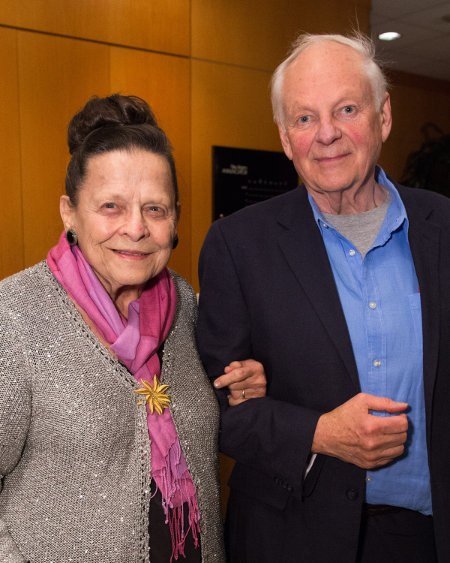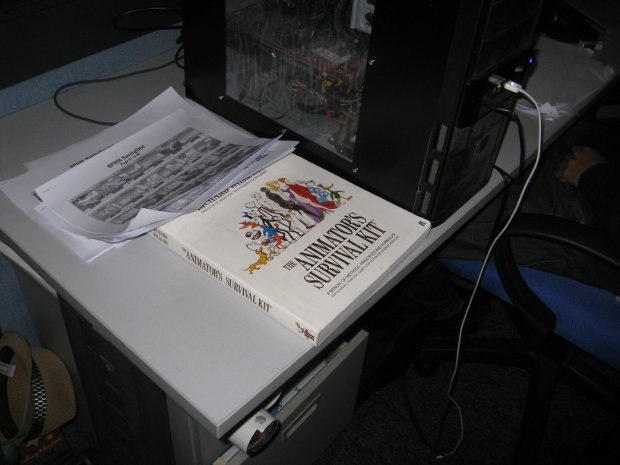The legendary 3-time Oscar winning animator kicked off his interactive exhibition with a mesmerizing lecture.
Watch four video clips of Richard's lecture, where he talks about the making of Snow White and the Seven Dwarfs, A Christmas Carol, The Jungle Book and Who Framed Roger Rabbit, all on AWNtv.
After 14 years of wrangling, Randy Haberkamp finally got his man. Presented as part of the Marc Davis Celebration of Animation, the legendary Richard Williams took to the Samuel Goldwyn Theatre stage last Friday evening, entertaining and inspiring a packed audience in a two hour Masterclass that demonstrated once again not only his depth of insight and talent, but his unique position as an historic bridge to a bygone era of animation mastery. The evening also kicked off a two month interactive exhibition in the Academy’s Grand Lobby Gallery of Williams’ career in animation, complete with his new iPad app and artwork broken up into 12 separate learning / display pods.
Over the course of two hours, Williams, as spry and energetic at 80 as most Red Bull soaked animators a quarter his age, shared both the seminal moments that inspire him to this day as well as the key projects from his career where he was able, at least for a short spell, to put that inspiration to proper use.
Much has been written about Williams’ career, his triumphs, including three Academy Awards, most notably for his work on Who Framed Roger Rabbit, as well as his ultimately beloved but doomed animated masterpiece, the epic The Thief and the Cobbler. The man who at one point walked away from the industry he was so instrumental in shaping, has devoted almost 20 years now to channeling, distilling, consolidating and presenting the fundamental knowledge gleaned from his own 57 year career as well as from some of our industry’s most famous animators. Initially packaged in 1995 and presented in a series of 5-day Masterclasses, then followed up in 2002 by his must-have Animator’s Survival Guide book, in 2009 with a companion DVD set, and in 2013 now integrated into an interactive iPad app, William’s unique understanding of the animation process was forged over a lifetime spent learning and re-learning the fundamentals of what it means to animate.
On stage, Williams was always the humble master, constantly referring to himself as a “fraud” in comparison to icons such as Milt Kahl, Art Babbitt, Ken Harris and Grim Natwick, all of whom at various times he concurrently employed and studied under, a process he more than once described as “drinking their blood.” His quasi-autobiographical lecture was broken into two parts – Part One: How It Affected Me and Part Two: What I’ve Done With It. In Part One, using a succession of clips, Williams described how and why specific scenes from films like King-Size Canary, One Froggy Evening and The Jungle Book made such an indelible impact on the very nature of his understanding and practice of animation.
For example, he talked in reverential tones about Milt Kahl’s work animating Shere Khan in The Jungle Book. According to Williams, after seeing the film, “I came out of the screening a blithering wreck…I went back to my studio in a state of shock.” Williams eventually invited Kahl to London. Williams described their first meeting, as Kahl walked into the Soho studio lobby. “I didn’t know what to do. I ran up to him and I started shining his shoes...He said, “You don’t have to keep doing that” and I said, “Yes I do.” There was a big painting up on the wall, a bunch of men’s heads. He said, “Who did that?” I said, “Oh, that’s one of my paintings.” He said, “Well, you can stop shining because you draw better than me.” I said, “Oh, no, no, no.” And then he said, “Well, on the other hand, keep shining. Because you can’t animate worth shit.”
The second part of his presentation was devoted to showing some of his favorite work, including clips from The Charge of the Light Brigade, A Christmas Carol, The Return of the Pink Panther, Who Frame Roger Rabbit, The Thief and the Cobbler, his 2010 short Circus Drawings and 25 seconds of his current project, Will I Live to Finish This?, which he claims is his best work ever.
Earlier that Friday, I had a chance to talk to Richard about his career, the Academy exhibition and the extraordinary impact he has had on what is now a huge international animation education business.
Dan Sarto: Congrats on the exhibit and the special evening. I’m looking forward to your presentation.
Richard Williams: Thanks. The Academy has done a beautiful job with the exhibition.
DS: Tell me how this came about.
RW: For 14 years, Randy Habercamp has been asking me to do a lecture. For one reason or another it never came together. I had an exhibition in Annecy and the word got out and they suggested doing one here. Now, it’s interactive because we’ve just produced an iPad app. They setup the exhibition with 12 zones, one for each chapter of the app – flexibility, walks, dialogue, etc. It’s all interactive. It’s all animated. It combines The Animator’s Survival Guide book and DVDs we did previously. They decided to make an exhibition of it, which is marvelous.
DS: You were far ahead of the curve when it came to training and learning from the masters. You took it upon yourself to hire some of the most talented animators who’d ever held a pencil, just to learn from them. In the early days of your career, how did people learn about animation?
RW: Well, there was only the Preston Blair book and a horrid book by Halas [John] about logarithms and things. There was very little. It was a desert. I was just lucky. I happened to realize I didn’t know enough. I guess I was the only one who thought to hire guys like Ken Harris and Art Babbitt and keep them going for 14 years. An awful lot of it was just for my own benefit because I wanted to know this stuff. Foolishly, I invited my competition in London and suddenly, everyone started getting a lot better.
I thought, why isn’t anybody doing this? Why don’t people realize they don’t know anything? Everybody in the business had their egos working. When I started in London very early on I found I knew more than all these “professionals” and I was virtually a kid. I just decided to get busy. I had a small studio and I started tracing off films to figure the damn stuff out. Through Chuck Jones, I got in touch with Ken Harris. Both Ken and Art [Babbitt] were just about to retire. The Disney folks were quite secretive about their knowledge. But when they got old and realized they were going to croak, they became extremely generous. I just happened to hit them at the right time and roll on the floor in front of them and beg for scraps. And they gave me complete meals!
DS: I’ve always said more than most industries, animation venerates its elders.
RW: Well, they didn’t then. I will take credit for that. I realized, “Gosh, nobody’s paying any attention to these guys!” Everyone thought, “Oh, they just do that smooth stuff.” I knew just how great they were. I did everything possible to work with them. I was able to employ Ken Harris. He even got better, which was unbelievable. I gave him a lot of freedom. He flourished. And Babbitt revived himself and did some marvelous work. Grim [Natwick] was in the studio for a year as a tutor, walking around to everybody’s desk. I got him animating and he was well into his 90s.
Milt Kahl had a good 10 years left when they drove him out at Disney. These guys, I saw them get better. Titian got better. Degas got better. Rembrandt got better. Why not some animators? I definitely got better from years drinking blood from all these guys. I’m in terrific shape even though I’m old. I’m doing better work than I ever have.
DS: I’ve known you to be very modest and I’m sure it makes you a bit uncomfortable when people just talk about your legacy, how you’re a legend, when you’re still actively working. Did you ever imagine your book, DVD and now iPad app would have the impact they’ve had?
RW: My wife Mo [Imogen Sutton] said to me that this material will have a great impact. I said, “Well…maybe…” But she said, “No no, these will do well. This will help everybody.”
But also, you get attention when you’re really old. Babbitt always said, “They give you prizes before you go gaga!” You’re prized for longevity. I always sought out these really old guys. I got involved with Ken when he was 69. I thought that was old as hell. I’m just in shock at being 80. It’s ridiculous.
DS: Looking back at some of the highlights of your career, when you were making Who Framed Roger Rabbit, did you ever expect the film to be so successful, to have the impact it did then and still has today?
RW: Everybody on it could tell it was going to be a hit. We didn’t know how big, but you could tell. There’s a scene in the first cartoon when Roger is coming out of the fridge. I did that scene. When I saw it finished for the first time, I thought, “Oh, this is going to be a hit.” I am surprised that it holds up. At least everybody tells me it does. At the time I thought, “This is rehash. But it’s hit rehash.”
DS: Well it holds up not just because of sentimentality or nostalgia. It holds up because it’s a great film and the animation is tremendous. Even today, you couldn’t make it look any better, no matter what technique or technology you used. That’s why classic Disney animated films hold up so well. The style is always relevant. The beauty of the art…you could possibly recreate it but it’s not like you could surpass it.
RW: Exactly. Absolutely. Amen.
DS: Last question. Is there anything you can point to in your career that gives you the most sense of personal satisfaction?
RW: Yes. There were six months on The Thief. We’d done 20 years of work, working on certain shots that whole time. If you can believe it, during the entire time we worked on the film, with all those people, there were six months when we had four people in administration, and we had the most efficient and smooth production I’ve ever experienced. Every day, I’d see these wonderful shots coming to fruition. It went on for six months. And I thought, “This is heaven.” But then of course, tragedy struck.
Now, I can say, the high point of my career, truthfully, is right now. The work I’m doing now I could never have done even when I was 70. Something happened to me around age 75 and it all “took.” Now I’m able to do anything I can think of. So, we’ll see if I can stretch this thing out because I’m now doing my masterpiece. And the fuckers can’t stop me now! The only thing that can get me is Mother Nature.
--
Dan Sarto is editor-in-chief and publisher of Animation World Network.
Dan Sarto is Publisher and Editor-in-Chief of Animation World Network.














